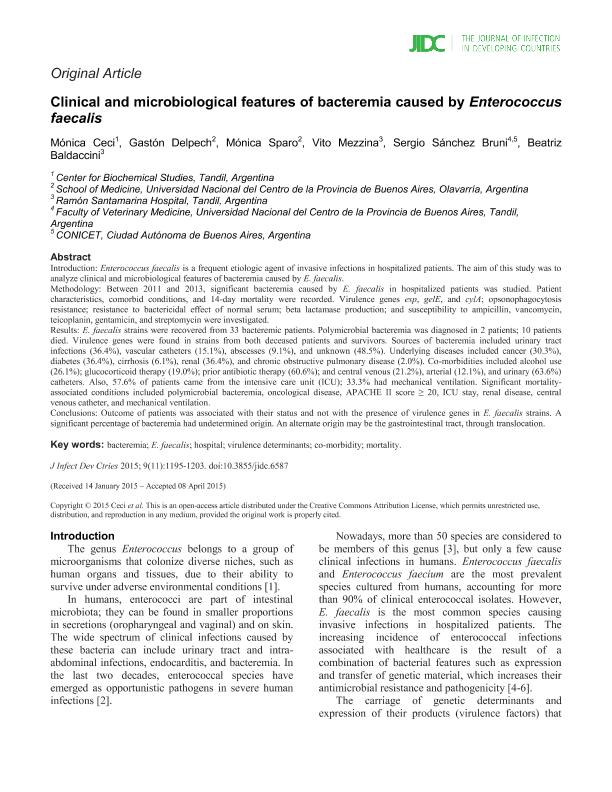Artículo
Clinical and microbiological features of bacteremia caused by enterococcus faecalis
Ceci, Mónica; Delpech, Gastón ; Sparo, Mónica Delfina; Mezzina, Vito; Sanchez Bruni, Sergio Fabian
; Sparo, Mónica Delfina; Mezzina, Vito; Sanchez Bruni, Sergio Fabian ; Baldaccini, Maria Beatriz
; Baldaccini, Maria Beatriz
 ; Sparo, Mónica Delfina; Mezzina, Vito; Sanchez Bruni, Sergio Fabian
; Sparo, Mónica Delfina; Mezzina, Vito; Sanchez Bruni, Sergio Fabian ; Baldaccini, Maria Beatriz
; Baldaccini, Maria Beatriz
Fecha de publicación:
11/2015
Editorial:
JIDC
Revista:
Journal of Infection in Developing Countries
ISSN:
2036-6590
e-ISSN:
1972-2680
Idioma:
Inglés
Tipo de recurso:
Artículo publicado
Clasificación temática:
Resumen
Introduction: Enterococcus faecalis is a frequent etiologic agent of invasive infections in hospitalized patients. The aim of this study was to analyze clinical and microbiological features of bacteremia caused by E. faecalis. Methodology: Between 2011 and 2013, significant bacteremia caused by E. faecalis in hospitalized patients was studied. Patient characteristics, comorbid conditions, and 14-day mortality were recorded. Virulence genes esp, gelE, and cylA; opsonophagocytosis resistance; resistance to bactericidal effect of normal serum; beta lactamase production; and susceptibility to ampicillin, vancomycin, teicoplanin, gentamicin, and streptomycin were investigated. Results: E. faecalis strains were recovered from 33 bacteremic patients. Polymicrobial bacteremia was diagnosed in 2 patients; 10 patients died. Virulence genes were found in strains from both deceased patients and survivors. Sources of bacteremia included urinary tract infections (36.4%), vascular catheters (15.1%), abscesses (9.1%), and unknown (48.5%). Underlying diseases included cancer (30.3%), diabetes (36.4%), cirrhosis (6.1%), renal (36.4%), and chronic obstructive pulmonary disease (2.0%). Co-morbidities included alcohol use (26.1%); glucocorticoid therapy (19.0%); prior antibiotic therapy (60.6%); and central venous (21.2%), arterial (12.1%), and urinary (63.6%) catheters. Also, 57.6% of patients came from the intensive care unit (ICU); 33.3% had mechanical ventilation. Significant mortality-associated conditions included polymicrobial bacteremia, oncological disease, APACHE II score ≥ 20, ICU stay, renal disease, central venous catheter, and mechanical ventilation. Conclusions: Outcome of patients was associated with their status and not with the presence of virulence genes in E. faecalis strains. A significant percentage of bacteremia had undetermined origin. An alternate origin may be the gastrointestinal tract, through translocation.
Palabras clave:
Bacteremia
,
Co-Morbidity
,
E. Faecalis
,
Hospital
,
Mortality
,
Virulence Determinants
Archivos asociados
Licencia
Identificadores
Colecciones
Articulos(CIVETAN)
Articulos de CENTRO DE INVESTIGACION VETERINARIA DE TANDIL
Articulos de CENTRO DE INVESTIGACION VETERINARIA DE TANDIL
Citación
Ceci, Mónica; Delpech, Gastón; Sparo, Mónica Delfina; Mezzina, Vito; Sanchez Bruni, Sergio Fabian; et al.; Clinical and microbiological features of bacteremia caused by enterococcus faecalis; JIDC; Journal of Infection in Developing Countries; 9; 11; 11-2015; 1195-1203
Compartir
Altmétricas



